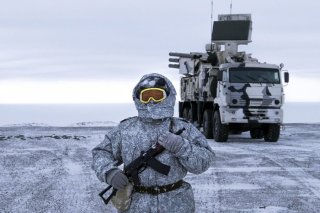The Final Frontier on Earth: Arctic Expansion
"The Americans are forcing Russia to increase its military spending and spend more resources on ensuring the military security of the Northern Sea Route,” said retired Lt. Col. Vladimir Ovchinnikov
Here's What You Need to Remember: Russia has steadily built up its Arctic military posture in recent years with bases, weapons installations, and other military infrastructure along the country’s northern coastline and adjacent territories.
Russia’s military is reviewing plans to create a new fleet, according to sources within the Navy.
“The Russian Arctic Fleet, a new structure, is under consideration,” a Navy source told Russia’s TASS state news outlet. “It will be a separate formation within the Navy, and its responsibility will be to ensure the safety of the Northern Sea Route and the Arctic coast in the area of responsibility of the Northern and Pacific fleets.”
The source added that the Arctic Fleet is intended to complement, not replace, the existing Northern Fleet. “The plan is that the infrastructure of the new association will be separate from the Northern and Pacific fleets,” the source told Tass. “In the future, it will have ships and special equipment suitable for the Arctic. The Northern Sea Route is a shipping route spanning Russia’s Arctic coast, stretching from the Kara Sea to the Bering Strait.
This news remains uncorroborated and unconfirmed by the Russian government as of the time of writing. Nevertheless, TASS has distinguished itself in prior years as a generally reliable source of information on Russia’s military and defense industry.
Russia’s Navy currently consists of the Baltic, Pacific, and Black Sea fleets, as well as the Caspian Flotilla. A new fleet, exclusively dedicated to guaranteeing the integrity of the Northern Sea Route, could help to streamline the duties of Russia’s other fleets, making for more effective and resource-efficient deployment rotations across the Navy. It is unclear to what extent the Arctic Fleet will be constituted through hardware transfers from other fleets, as opposed to brand new equipment. It also remains to be seen how big this prospective fleet will be, given its relatively modest role.
Moscow has expressed concerns that the United States, which is reportedly planning to build six new icebreaker ships through 2029, seeks to ramp up its military presence along the Northern Sea Route with airpower and submarines. Russian observers reacted with alarm to the recent flight of three U.S. B-2 stealth bombers from the Whiteman Air Force Base in Missouri to the Keflavik Air Base in Iceland, the first such deployment since 2006. “The Americans are forcing Russia to increase its military spending and spend more resources on ensuring the military security of the Northern Sea Route,” said retired Lt. Col. Vladimir Ovchinnikov. “However, I think that these expenses will be justified. The traffic of goods through Russia's Arctic ports has grown this year.” Discussions around a prospective Arctic Fleet signal the Kremlin’s renewed resolve to secure its maritime interests against the perceived threat of NATO encroachment.
Russia has steadily built up its Arctic military posture in recent years with bases, weapons installations, and other military infrastructure along the country’s northern coastline and adjacent territories. “Russia is refurbishing Soviet-era airfields and radar installations, constructing new ports and search-and-rescue centers, and building up its fleet of nuclear- and conventionally-powered icebreakers,” Lt. Col. Thomas Campbell told CNN. Russia’s military also has taken steps to integrate large swathes of the Arctic into its sprawling air/missile defense network, installing S-400 “Triumf” and S-300P missile systems on the Novaya Zemlya Archipelago to Russia’s north.
Mark Episkopos is a national security reporter for the National Interest.
This article is being reposted due to reader interest.
Image: RKK/ICDS

